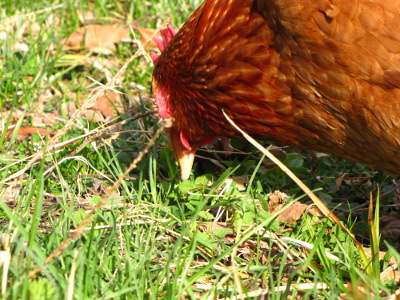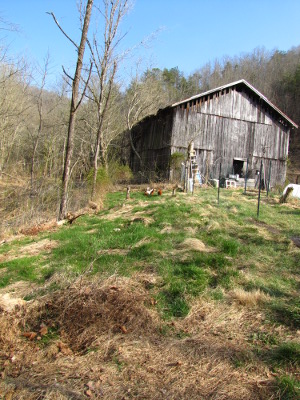
Chicken pasture size and rotation
 To
get the most food-value out of your pasture, you not only need to raise
chicken breeds that forage aggressively, you also have to plan your
pasture size and rotation well. I looked
everywhere last year to
figure out how big a pasture needs to be to provide a large component
of a chicken's dietary needs, and drew a complete blank. Finally,
this winter, I stumbled across the figure of 10
square feet of pasture
per bird per week
(with frequent rotations) in Raising Poultry on Pasture: Ten Years of
Success.
Granted, the type of operation outlined in the book uses pasture more
as a source of vitamins and minerals than as the flock's primary food,
but I thought their area estimate would give me an idea of the bare
minimum amount of land needed to graze our birds.
To
get the most food-value out of your pasture, you not only need to raise
chicken breeds that forage aggressively, you also have to plan your
pasture size and rotation well. I looked
everywhere last year to
figure out how big a pasture needs to be to provide a large component
of a chicken's dietary needs, and drew a complete blank. Finally,
this winter, I stumbled across the figure of 10
square feet of pasture
per bird per week
(with frequent rotations) in Raising Poultry on Pasture: Ten Years of
Success.
Granted, the type of operation outlined in the book uses pasture more
as a source of vitamins and minerals than as the flock's primary food,
but I thought their area estimate would give me an idea of the bare
minimum amount of land needed to graze our birds.
I've talked Mark into
building me five new pastures this year to join
our current two pastures from last year. Our old pastures are
small and shady in the winter, so I plan to mostly use them to grow
some grains and legumes to supplement the chickens' winter feed, though
I will graze the chickens there for a short time in the fall.
Three of the new pastures will be in the sunniest part
of the yard for
winter and spring grazing, while two more will be on the hillside above
the original pastures for summer shade. I estimate that the total
square footage from all seven pastures will be about 4250 square feet
(a tenth of an acre), which (I hope) will be enough to keep our
chickens healthy all year.
 Optimal rotation frequency is
another big question mark. Last
year, I kept the chickens in their pastures way too long, mostly
because I wanted them to scratch the ground bare so I could use those
paddocks to plant grain in. For most of our pastures this year,
though, I want to keep the pastures vegetated at all times for optimal
chicken health. When rotationally grazing with ruminants (like
cows and sheep), the goal is to make your livestock eat everything to
the ground
in a short period of time (mob grazing), then move the animals to
another section of the pasture for a while to let the plants grow
back. This will give you lots of tender growth rather than
leaving you with a pasture denuded of the good stuff and with lots of
plants your livestock don't want to eat, which is what you get if you
leave your livestock in a pasture continuously.
Optimal rotation frequency is
another big question mark. Last
year, I kept the chickens in their pastures way too long, mostly
because I wanted them to scratch the ground bare so I could use those
paddocks to plant grain in. For most of our pastures this year,
though, I want to keep the pastures vegetated at all times for optimal
chicken health. When rotationally grazing with ruminants (like
cows and sheep), the goal is to make your livestock eat everything to
the ground
in a short period of time (mob grazing), then move the animals to
another section of the pasture for a while to let the plants grow
back. This will give you lots of tender growth rather than
leaving you with a pasture denuded of the good stuff and with lots of
plants your livestock don't want to eat, which is what you get if you
leave your livestock in a pasture continuously.
Mob grazing works great
for cows, but I'm not sure yet whether it's the
best plan with chickens. Although chickens do nibble on leaf
matter from time to time, a healthy chicken is mostly eating
invertebrates, fruits, and seeds, so I should really be managing our
pasture to promote creepy crawlies, not grass. Tomorrow, I'll
write about what I'm planting in the pastures to keep the chickens fed,
but for now I'll just say that I don't really have a clue yet whether I
should be rotating the chickens quickly, thus keeping the browse low
and tender, or infrequently, thus attracting more grasshoppers.
I'll just have to keep an eye on the flock and pasture conditions and
make it up as I go along.
 This post is part of our Chicken Pasture lunchtime series.
Read all of the entries: This post is part of our Chicken Pasture lunchtime series.
Read all of the entries: |
Want more in-depth information? Browse through our books.
Or explore more posts by date or by subject.
About us: Anna Hess and Mark Hamilton spent over a decade living self-sufficiently in the mountains of Virginia before moving north to start over from scratch in the foothills of Ohio. They've experimented with permaculture, no-till gardening, trailersteading, home-based microbusinesses and much more, writing about their adventures in both blogs and books.
Want to be notified when new comments are posted on this page? Click on the RSS button after you add a comment to subscribe to the comment feed, or simply check the box beside "email replies to me" while writing your comment.

We don't have as much space as you do, but what about rotating 2 spaces at a time. Rotate into one, and as it gets long in the tooth open up the second pasture. I have 2 'pastures' (I'm a city guy), but I have an older area I keep open as I rotate the chicks to my garden beds. They not only keep the new areas clean, but patrol the old area too. The old area looks like a moon scape to me, but they seem to keep finding stuff. If I had the space to keep 5 pastures I would rotate the chicks through 2 pastures of garden area at a time, with the coop in the center.
Well, thats my goal at least. Keep up the good work Cheers Shane
I am reading your blog with keen interest. You seem to have a lot of the answers to questions I am asking.
We just purchased a house that has an area that is a long-forsaken dog run. It is covered and fenced already. Just need to adapt the shelter for chickens. The run is very shady and has nothing of value growing in it. In fact it is mostly dirt and fallen leaves. We just hacked down a bunch of volunteer trees growing up through the fencing. What can I plant that will grow in shade? The tree is deciduous, so in winter the area will get more sun. After I get this pasture going, I am going to work on adding more like you propose.
Lesley --- That's a good question, but there's no single right answer for every region. I can point you in the right direction to start your research, though.
All Flesh is Grass is a good starter book for folks with a small space trying to wrap their mind around pasture.
My chicken blog is where I've posted much more about this topic than over here, especially under the forest pasture and pasture rotation tags.
Now, back to specifics, a few things I'd especially suggest you look into. Do you live in a region where cool season or warm season grasses dominate? Do you really want to plant something and wait a year for it to get established enough that chickens won't wreck it, or would you rather just mow the current weeds every time they get a bit tall and let the natural grasses and forbs establish in a shorter time period? Or, given your shade situation, would you be better off with a run completely mulched with leaves and not try to grow anything? Do you want to try to make the pasture more chicken friendly (since chickens aren't set up to digest much grass) by adding fruit-bearing perennials?
I'm actually working on an ebook on this topic, so if you stay tuned, I'll probably have something more coherent for you by the end of the winter.
Anna, Thanks for the reply and links. I'll check those out.
I am in North Central Texas, so fairly mild winters and brutal summers. Although, winter can see quite a bit of below freezing temps, and we often get a couple days of ice. Those are mixed with many days of 40s and 50s.
I am open to any ideas. I have read about creating a wire-covered patch in the chicken yard so that the chickens can't scratch the plants to death. So, I may try something like that - even if I just put wire mounted on 2x4s around the perimeter, then plant in the dirt.
I have been reading more since my first post. I could plant chard, asian greens and some other things. I've even read chickens will eat hostas.
I am open to planting perennials as well, including small fruiting shrubs. Nothing big, though.
Hi,
Is the 10 sq ft per chicken per week really a good number? I can't imagine keeping 100 birds in 1000 sq ft, and the condition of the pasture after one week of manure. One day rotations would give you 142 sq ft for 100 birds. This just seems so small, even at such quick rotations. Wouldn't the nitrogen burn plants and change pH over time at this density?